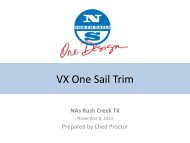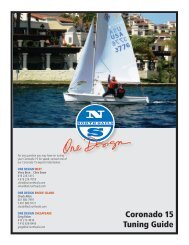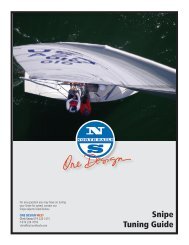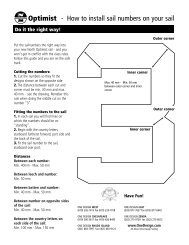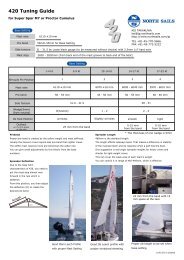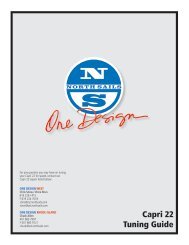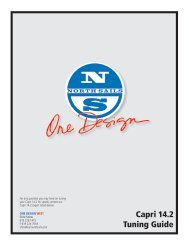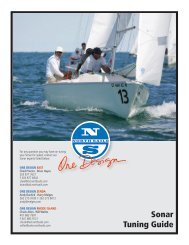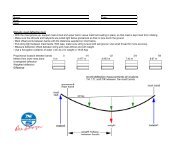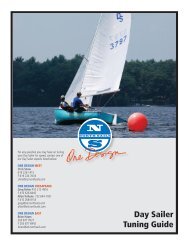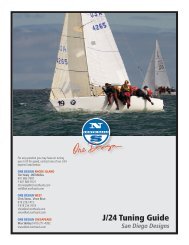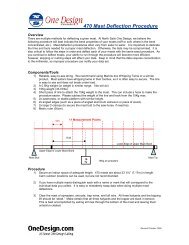Star Tuning Guide - North Sails - One Design
Star Tuning Guide - North Sails - One Design
Star Tuning Guide - North Sails - One Design
- No tags were found...
Create successful ePaper yourself
Turn your PDF publications into a flip-book with our unique Google optimized e-Paper software.
NORTH SAILS<strong>Star</strong> <strong>Tuning</strong> <strong>Guide</strong>rig tuningTo measure the shroud tension we use theLoos Pro Model Gauge (PT-1).Using the Loos Gauge, start by putting 5on each upper backstay. Now check yourrake measurement. 16 ½” to 16 ¾” (42to 43 cm) seems to work well on mostboats.Now using the Loos Gauge measurethe tension on your upper shrouds. Thisshould be 22 to 23.Finally you need to set-up your inner lowershrouds. First measure up from the tip ofthe black band along the mast 36” (91.5cm) and make a mark. Now measureacross from shroud to shroud. By pullingthe shrouds together this measurementshould be 28½” to 29 ½” (72.5 to 75 cm).Now you are set to go sailing. Themeasurements and settings that we havesuggested are a very good starting point.You might have to make some small adjustmentsto fit your sailing style and crewweight.Sail Trim on the WaterMainThe most important adjustment for themain is the main sheet itself. Smalladjustments make very obvious changesin performance and balance of yourboat. Trimming harder gives you a tighterleach with more power and helm, whichtranslates in to pointing higher. An easedmain gives you a more twisted sail, whichtranslates into less helm and the ability togo fast forward. The difference betweenbeing trimmed hard and eased might onlybe 1” to 2” (2.5 to 5 cm) of trim on themain sheet. If you have a single type mainsheet marking it is a good idea so thatyou can reproduce your settings. If youuse a double type main sheet you cannotmark the sheet so you will have to look atthe main to judge your main sheet trim.Typically the boom will be 7 – 8” (17.5to 20.5 cm) off the deck at the transomin moderate conditions, closer in heavyconditions and further off the deck as itgets lighter.The outhaul controls the depth in the bottomthird of the sail. In very light air andflat water the outhaul should be pulledout tight near the band. As the water getsrougher and the wind picks up you canease the outhaul in but no more than 1½” (3.8 cm) from the band. As you startto get over powered pull the outhaul backon until it is at the black band in 14 knotsof wind.In all but the windiest conditions the Cunninghamshould only be used to just pullthe wrinkles out of the luff of the main.As you start to get overpowered you willhave to pull harder on the Cunninghamto help open the top of the main and depowerthe boat. But it is very importantto ease the Cunningham as soon as theconditions get lighter.Your backstays are two more adjustmentsthat help you get the most out of yoursails. The lower backstay controls thebend in the lower part of the mast. In verylight air and flat water there should be notension on your lower backstays. As thewind increases and the water gets rougheryou will need to pull on your lower backstayto give the boat enough power to sailthrough the waves. As the wind furtherincreases and you start to get overpoweredyou can start to put some tension onyour upper backstays. This bends the mastwhich helps flatten the sail and twistsopen the top part of the main. Also thistensions the head stay which makes theVisit our web site at www.<strong>One</strong><strong>Design</strong>.com for the latest <strong>Star</strong> news and tuning tips.© 2007 <strong>North</strong> <strong>Sails</strong> <strong>One</strong> <strong>Design</strong>. All rights reserved.2
NORTH SAILS<strong>Star</strong> <strong>Tuning</strong> <strong>Guide</strong>Sail CareYour <strong>North</strong> <strong>Sails</strong> are constructed out of thebest materials on the market today. Wemake sure of this by testing every roll ofcloth we use. Through proper care andmaintenance your sails will give you theperformance you have come to expectfrom a <strong>North</strong> Sail.The most important factor for a long lifefor your sails is to watch them for signsof wear and tear in high load and chafeareas. Be sure to wash the sails off withfresh water and dry the sails thoroughlybefore storing. A dry, mild climate is best.Excessive heat can cause problems withthe sails due to the possibility of shrinkage.It is best to roll the mainsail and jib.MainsailWhen hoisting and lowering the sail try tominimize the amount of creasing or wrinklingof the sail. Every time the sail gainsa crease the cloth breaks down that muchfaster. Always have someone contain theleech and luff during these procedures.The battens can be left in the sail withoutany problems. Be sure to roll the saildown the leech so that the battens willjot twist. This could cause damage to thebattens.JibWhen rolling the jib keep the battensperpendicular to the leech. Pay special attentionto the batten pockets for wear andtear. Since this sail is manufactured fromyarn tempered Dacron, problems can arisedue to mishandling.<strong>Star</strong> Boat ClinicsThis tuning guide only begins to cover allthere is to know about racing the <strong>Star</strong>.The <strong>Star</strong> team at <strong>North</strong> <strong>One</strong> <strong>Design</strong> hasprepared a professional, in depth <strong>Star</strong> boatracing clinic that you and your fleet will beinterested in learning more about. In thecourse of an evening or weekend you willlearn more about racing you <strong>Star</strong> than youcould possibly learn in a season of racingon your own.Please call your nearest <strong>North</strong> <strong>One</strong> <strong>Design</strong>loft for complete details!At <strong>North</strong> <strong>Sails</strong> we are constantly striving tomake our products better. If you have anycomments on this tuning guide and how itcould be improved for your purposes we’dlove to hear from you.Please give us a call or drop us a line.Good Racing!Contact UsFor tuning information and complete detailson how to setup your <strong>Star</strong> sails do nothesitate to contact the <strong>North</strong> <strong>Star</strong> Teamlisted on the cover of this guide.TENSION GAUGE CONVERSIONCHARTOver the past few year Loos Co. hasintroduced it's new style PT-1, 2 and 3professional tension gauges to the market.Since many of us are replacing our oldermodel A and B gauges with these newmodels we are posting the followingconversion chart for your convenience.MODEL A MODEL PT-13/32 1/8 5/325 610 915 12 1420 16 1625 20 1928 23 2130 2235 27 2538 30 2840 33 3042 3344 3645 3846 3947 40Model B Model PT-2 PT-33/16 7/32 1/4 9/3210 1115 1318 1520 16 1822 18 2024 19 2226 21 2428 23 2530 25 27 2532 27 29 2734 29 31 2933 3136 33 637 36 737 91011121416182025Visit our web site at www.<strong>One</strong><strong>Design</strong>.com for the latest <strong>Star</strong> news and tuning tips.© 2007 <strong>North</strong> <strong>Sails</strong> <strong>One</strong> <strong>Design</strong>. All rights reserved.4
NORTH SAILS<strong>Star</strong> <strong>Tuning</strong> <strong>Guide</strong>NORTH SAILS ONE DESIGNQUALITY CONTROL CHECKMAINSAILCornersCunninghamTack and Clew slugsLeech LineRoyaltyNumbersCountry CodeBattens2 Batten LoadersLeech TelltalesInsignia<strong>North</strong> LogoBagJIBCornersBattensZipperTelltalesLeech telltalesRoyalty<strong>North</strong> LogoBagChecked by: ______________________Date: ____ / ____ / ____Visit our web site at www.<strong>One</strong><strong>Design</strong>.com for the latest <strong>Star</strong> news and tuning tips.© 2007 <strong>North</strong> <strong>Sails</strong> <strong>One</strong> <strong>Design</strong>. All rights reserved.5



